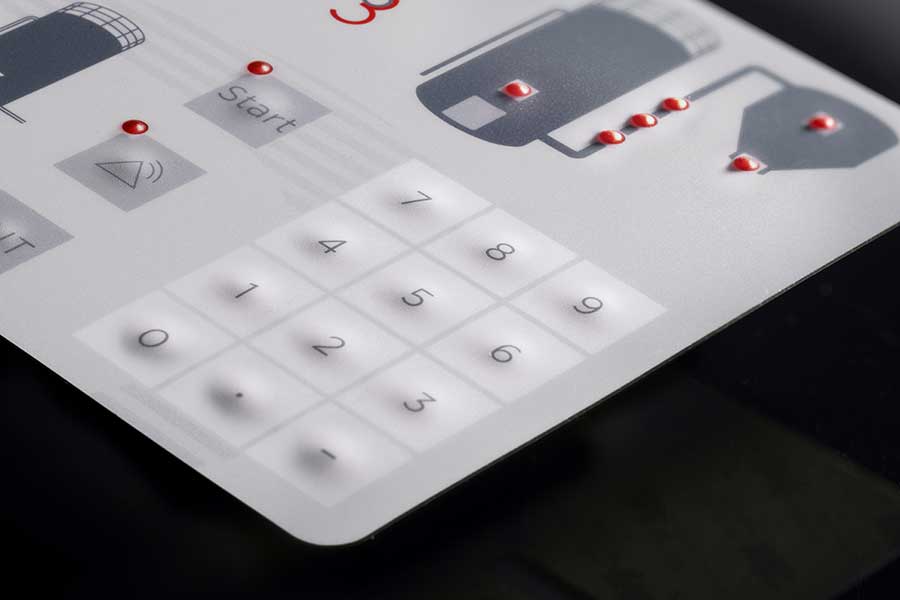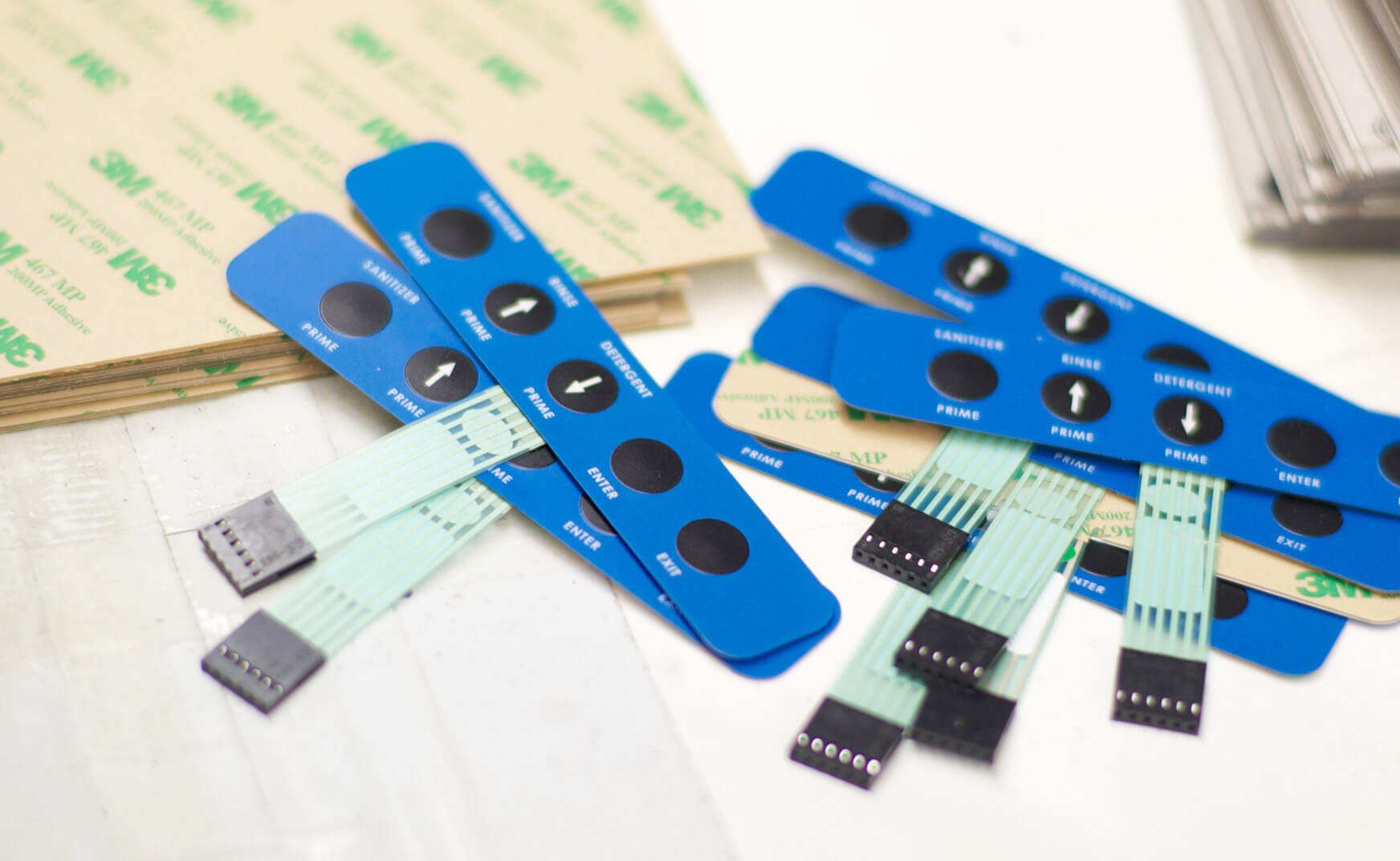Choosing a domestic membrane switch manufacturer can cut down on lead times and transportation costs.
Everything About Membrane Change: Recognizing Its Design and Capability
When you believe regarding the control user interfaces in contemporary tools, membrane buttons frequently come to mind. Allow's explore what sets membrane switches apart from various other control systems.
What Are Membrane Layer Switches?

Their seamless nature makes them easy to clean and resistant to dirt and moisture, an essential feature in many atmospheres. Membrane layer switches can additionally be tailored regarding form, size, and graphics, enabling suppliers to develop one-of-a-kind user interfaces customized to details items. And also, they're lightweight and thin, which helps in lessening the general bulk of devices. Overall, membrane switches play a considerable role in enhancing individual experience throughout a large variety of applications.
Just How Membrane Changes Job
When you push a key on a membrane layer button, it turns on a simple yet reliable mechanism. The leading layer, usually made from flexible product, lowers onto a conductive layer beneath it. This action bridges the void in between conductive traces, finishing an electric circuit. As quickly as the circuit shuts, it sends out a signal to the tool's controller, which analyzes your input.
You'll discover that the responsive comments varies based on the button layout, providing either a soft click or an extra noticable feedback. Once you release the trick, the membrane layer go back to its initial position, resuming the circuit and quiting the signal. This procedure occurs almost instantly, ensuring a responsive individual experience.
Membrane layer switches are prominent as a result of their longevity and resistance to dirt and wetness, making them suitable for numerous applications, from household appliances to clinical gadgets. Recognizing this procedure helps you appreciate their extensive usage.
Key Elements of Membrane Layer Switches
Comprehending the crucial parts of membrane layer switches is fundamental for understanding their performance and style. At the core, you'll discover the visuals overlay, which supplies the visual interface for individuals. Below that, there's a spacer layer that separates the circuit layers, ensuring that they don't make contact until pressed. The circuit layer is where the magic happens; it contains conductive traces that complete the circuit when you press the button. Another crucial aspect is the glue backing, enabling the switch to follow surface areas securely. The safety layer shields against ecological elements and wear, expanding the button's life expectancy. Each element plays a considerable function in making sure trusted efficiency and individual interaction. By comprehending these elements, you'll gain understanding into exactly how membrane switches operate and their significance in numerous applications.
Products Utilized in Membrane Layer Change Design
The efficiency and resilience of membrane layer switches heavily depend on the materials made use of in their style. You generally come across polyester and polycarbonate as key substrates because of their excellent toughness and adaptability. These products resist scrapes and chemicals, making them excellent for demanding atmospheres.
The conductive layers typically utilize silver or carbon, picked for their dependability and conductivity. membrane switch manufacturer. Silver provides remarkable performance, while carbon is a cost-efficient alternative. For the overlay, you might consider a matte or glossy surface, depending upon your aesthetic needs and customer experience
Adhesives play a necessary duty too; they bond layers look at this web-site securely and assure longevity. Make sure to choose adhesives that stand up to ecological elements like temperature level and moisture. Do not neglect the value of a great printing method for graphics, as it enhances both performance and aesthetic allure. Picking the appropriate materials will certainly assure your membrane layer button stands the examination of time.
Design Factors To Consider for Membrane Layer Buttons
While creating membrane layer switches, it's essential to take into account numerous elements that influence their performance and user experience. Beginning by focusing on the layout and button dimension; make certain they're instinctive and simple to browse.
Verify your style fits ecological variables, like moisture or temperature variations, which can influence efficiency. By thoroughly thinking about these components, you'll produce a membrane switch that enhances use and fulfillment.
Applications of Membrane Layer Buttons
Membrane buttons are versatile elements found in various applications, from commercial tools to customer electronic devices. You'll see their effect in devices that require resilient user interfaces and in tools that profit from sleek designs. Recognizing these applications helps you value the performance and practicality of membrane layer switches in day-to-day modern technology.
Industrial Tools Use
When you're wanting to enhance the performance of industrial equipment, membrane layer switches supply a dependable remedy that integrates sturdiness with user-friendly layout. These switches are best for severe environments, supplying resistance to dust, dampness, and chemicals. You'll find them in control panels for producing equipments, cooling and heating systems, and medical tools, where precision and responsiveness are vital. Their reduced account indicates they fit seamlessly right into numerous devices, conserving important room see this while preserving convenience of usage. With customizable graphics and backlighting choices, you can develop an intuitive user interface for operators, improving efficiency and security. And also, their lengthy life expectancy decreases upkeep prices, making them a smart financial investment for your commercial applications. Welcome membrane layer buttons to streamline your operations and enhance total performance.
Customer Electronic Devices Combination
In the domain of customer electronics, membrane layer switches play an important role in improving user communication and device performance. Membrane buttons also assure resilience and resistance to dust and dampness, prolonging the life-span of your electronic devices. By choosing membrane layer buttons, you enhance not simply the functionality yet likewise the style of your tools, making day-to-day interactions smooth and enjoyable.
Benefits and Drawbacks of Membrane Buttons
While membrane switches supply a series of benefits, they additionally come with some downsides that you should take into consideration. One significant benefit is their small layout, making them optimal for space-constrained applications. They're additionally affordable, providing a long lasting solution with a low manufacturing cost. Furthermore, their smooth surface is simple to clean, boosting hygiene in atmospheres like healthcare facilities.

However, there are negative aspects. Membrane layer buttons can have a much shorter life-span compared to mechanical buttons, particularly under heavy use. They can likewise be much less responsive, which could influence customer responses throughout operation. If harmed, repairing them can be challenging and usually calls for complete substitute. Inevitably, their level of sensitivity to extreme temperatures and environmental problems may limit their efficiency in certain settings. Stabilizing these benefits and drawbacks will certainly help you figure out if membrane layer switches are the right suitable for your job.
Often Asked Concerns
The Length Of Time Do Membrane Switches Over Commonly Last?
Membrane layer changes usually last in between 5 to one decade, depending on usage and environmental conditions. You'll intend to review aspects like wear, exposure to wetness, and temperature level changes to evaluate their long life efficiently.
Can Membrane Layer Switches Be Custom-made for Specific Styles?
Yes, you can personalize membrane switches to fit certain styles (membrane switch manufacturer). You'll have the freedom to pick shades, shapes, and designs that match your task's requirements, guaranteeing they blend flawlessly with your overall aesthetic
What Is the Price Range for Membrane Layer Switch Production?
The expense array for membrane switch manufacturing normally drops in between $1 and $10 per system, relying on variables like layout intricacy, quantity, and materials. You can get quotes from manufacturers to discover the very best alternative.

Are Membrane Switches Over Water-proof or Resistant?
Membrane switches can be created to be water-proof or resistant, depending upon materials utilized and building approaches. site If you require them for wet atmospheres, ensure you specify those demands throughout the layout process.
How Do Membrane Switches Compare to Traditional Switches?
Membrane switches are typically thinner and much more versatile than conventional switches, providing a streamlined style. They're frequently easier to clean and incorporate, yet might not offer the tactile responses you're made use of to with mechanical alternatives.
Verdict
